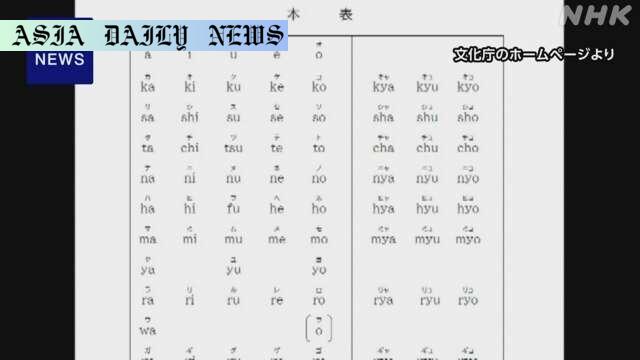Romaji: A Japanese government panel advocates updating the country’s Roman alphabet expression after seven decades.
Key Point 1: Japan’s government panel proposes the first update in romaji rules after 70 years.
Key Point 2: The Kunrei system, introduced in 1954, may be replaced by the more popular Hepburn system.
Key Point 3: The panel’s recommendation aims to align romaji usage with modern times, to be finalized this autumn.

Background on Japan’s Romaji Systems
The Japanese language has long presented challenges for romanization, the process of transcribing Japanese characters into the Roman alphabet. Over the years, two primary systems have surfaced for this purpose: the Kunrei system, which was officially adopted as a standard by the Japanese Cabinet in 1954, and the Hepburn system, which is more widely recognized and used. The Kunrei system is known for its logical alignment with traditional kana phonetics, using expressions like “ti” instead of “chi.” Hepburn, on the other hand, prioritizes ease of pronunciation for English speakers, reflecting sounds more familiar to them.
Despite Kunrei’s formal adoption, the general public, including students, professionals, and tourists, have shown a preference for Hepburn—the version often seen on signs, educational materials, and travel guides. This dichotomy has created inconsistencies in how Japanese is romanized, leading to confusion both domestically and internationally. It is this persistent misalignment and lack of adherence to Kunrei that has triggered the Japanese government’s initiative to reevaluate romaji systems after almost 70 years.
The Proposed Shift to Hepburn
The Cultural Affairs Agency of Japan has recently drafted a recommendation to prioritize Hepburn romanization over Kunrei, citing its widespread familiarity and practicality. According to the draft, Kunrei has failed to firmly take root among the general population despite being the official standard. By transitioning to a Hepburn-based system, the panel aims to harmonize Japanese romanization with modern expectations, particularly for international communication in an increasingly globalized world.
This potential shift holds significant implications. Hepburn’s prominence in the realm of education and public usage suggests that the transition may be relatively smooth. This change would cater to the needs of English-speaking audiences, eliminating confusion in pronunciation and improving accessibility to Japanese words for non-native speakers. However, this decision is not without controversy, as concerns about cultural preservation and the rejection of the traditional Kunrei system have been voiced by certain scholars and linguists in Japan.
Implications and Next Steps
This reconsideration of romaji systems is scheduled to culminate in an official recommendation by autumn. Should the proposal be adopted, it will be implemented as a Cabinet promulgation during the current fiscal year. Adoption of this updated system could set a precedent, reflecting Japan’s commitment to modernizing its linguistic practices while addressing contemporary societal needs.
The shift from Kunrei to Hepburn may also open broader discussions on other linguistic challenges Japan faces, such as English language education reforms and transliteration accuracy in legal and bureaucratic settings. As the government proceeds with its review and public feedback, it will be essential to strike a balance between functionality and tradition, ensuring that such changes truly benefit both Japanese speakers and international users.
Conclusion
The recommendation to transition from Kunrei to Hepburn romanization is a historic moment in Japanese linguistic policy, representing an acknowledgment of how societal realities and global interaction patterns have evolved. By prioritizing a system more reflective of modern communication needs, this decision may bridge gaps in language accessibility, foster better international engagement, and simplify the learner experience for those studying Japanese. However, ensuring that this change is thoughtfully implemented while respecting Japan’s linguistic heritage will be crucial in the years ahead.



Commentary
Embracing Change in Modern Times
The decision to reexamine Japan’s romanization systems is a fascinating development, showcasing the country’s recognition of language as a living, evolving entity. Over the past seven decades, society has transformed in ways that demand greater emphasis on accessibility and international communication. By revisiting romaji conventions, Japan demonstrates a willingness to adapt to these changes while maintaining its cultural narratives.
The Necessity of Modernization
The proposed move to adopt Hepburn romanization as the standard reflects the globalized world we live in today. Tourism, international diplomacy, and technological advancements have increased the need for Japan to present itself in ways that are easily understood by the global community. Hepburn, with its phonetic alignment to English, provides a practical and efficient way to address this need, offering clarity to learners, travelers, and non-Japanese speakers alike.
Balancing Tradition and Practicality
However, the debate over adopting Hepburn exposes a deeper cultural dilemma—balancing the preservation of traditions with the demands of a modern, interconnected world. Kunrei, though less intuitive for non-Japanese audiences, embodies a systematized, phonetic approach deeply rooted in Japanese linguistic practices. Shifting entirely to Hepburn may be seen by some as a departure from these traditional values.
Concluding Thoughts
Ultimately, Japan’s willingness to reevaluate its romanization system is a testament to its forward-thinking approach. As this debate unfolds, it will provide valuable lessons in how nations can adapt their linguistic policies to balance heritage with progress. This initiative, while sparking debate, stands as an important milestone in the continuous evolution of language in a rapidly globalizing world.